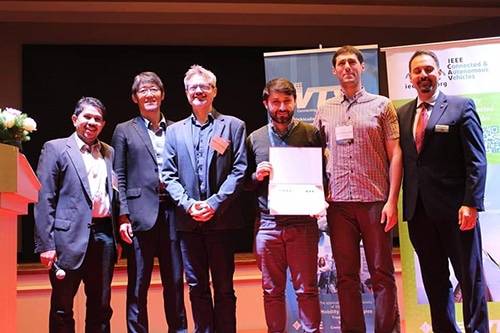May 14 2019
“Fog technology”, put together by scientists in the Faculty of Engineering, is a state-of-the-art computing infrastructure that could be central in enabling CAVs to be more efficient and safer.
 Award presentation ceremony: (from the left) Professor Hafizal Mohamad and Professor Tomoaki Ohtsuki (Technical Program Committee Co-chairs), Professor Robert Piechocki, Dr Andrea Tassi, Dr Ioannis Mavromatis (University of Bristol), Professor Alexander Wyglynski (IEEE VTS President). (Image credit: Bristol University)
Award presentation ceremony: (from the left) Professor Hafizal Mohamad and Professor Tomoaki Ohtsuki (Technical Program Committee Co-chairs), Professor Robert Piechocki, Dr Andrea Tassi, Dr Ioannis Mavromatis (University of Bristol), Professor Alexander Wyglynski (IEEE VTS President). (Image credit: Bristol University)
As the world gets ready for future transportation systems, the University of Bristol’s CSN group has been creating CAV technologies to open up societal benefits.
The technology engineered by the University is explained in the paper titled “Agile Data Offloading over Novel Fog Computing Infrastructure for CAVs” which won an award at the IEEE Vehicular Technology Conference (VTC), conducted in Kuala Lumpur in May 2019. VTC is the flagship conference of the IEEE Vehicular Technology Society and draws the world’s leading researchers and industrialists in the domains of 5G, wireless networks, automotive industry. The paper is a joint effort between the University of Bristol and Atkins and was bestowed the coveted “Best Conference Paper Award”.
The award-winning paper from academics in the The Communication Systems & Networks (CSN) Group from the University of Bristol’s Smart Internet Lab at the School of Computer Science, centers on the new model of the “Internet of Vehicles” and how the required infrastructure will revolutionize the system from a horde of autonomous cars that only tolerate each other to an orchestrated transportation machine.
Automated cars are already being tested on roads worldwide and the existing generation of CAVs is engineered to work in a totally autonomous mode. This mode necessitates them to follow highway code, drive safely, and transport passengers at a speed that is preferably not much slower than human-driven car would achieve. However, the much-indicated potentials of safer, quicker, and more predictable transportation can only emerge when the cars begin cooperating implicitly with one another as well as with road infrastructure.
The paper looks at how the new domain of collaborative CAVs will require the creation of new road infrastructure, with current assets such as road signage and traffic lights being enlarged (or even replaced) with distributed compute and Digital network infrastructures.
The CSN group at the University of Bristol is the chief cyber-physical infrastructure architect within the FLOURISH project consortium. The FLOURISH project is a collaboration that develops and prototypes such new Cyber-physical set-ups for future automated vehicles.
The group has created a unique Fog Compute framework. The concept behind the Fog framework is that it augments cloud computing with extra resources which are situated in the proximity of CAVs. This decreases the latency of communication between vehicles and the infrastructure and facilitates extra safety critical services. The Fog resources are also used to allow high-tech trust certificates compression, network coding, and CAV data offloading technologies.
The cooperation between self-driving vehicles will require the exchange of vast amounts of data with the road-side infrastructure. In our paper, we present a way of decoupling the relay of sensor data to and from Connected and Autonomous Vehicles, with the resource-intensive task of processing them.
Dr Andrea Tassi, Study Lead Author, University of Bristol
We do so by employing a network of Fog Compute nodes and designing an agile and reliable data-offloading mechanism. Building upon our real-world, large-scale urban trials, we validated the effectiveness and feasibility of our proposal.
Dr Ioannis Mavromatis, University of Bristol
I am absolutely delighted for our team to receive this very prestigious award. This is a culmination of many years of research and hard work of a large number of people. It was a joy and privilege to take these concepts from initial sketches and derivations on whiteboards to the actual novel hardware and software deployed and tested on our Clifton campus. It is delightful to know that our efforts are appreciated by the wider scientific community.
Robert Piechocki, Project Lead and Professor, University of Bristol